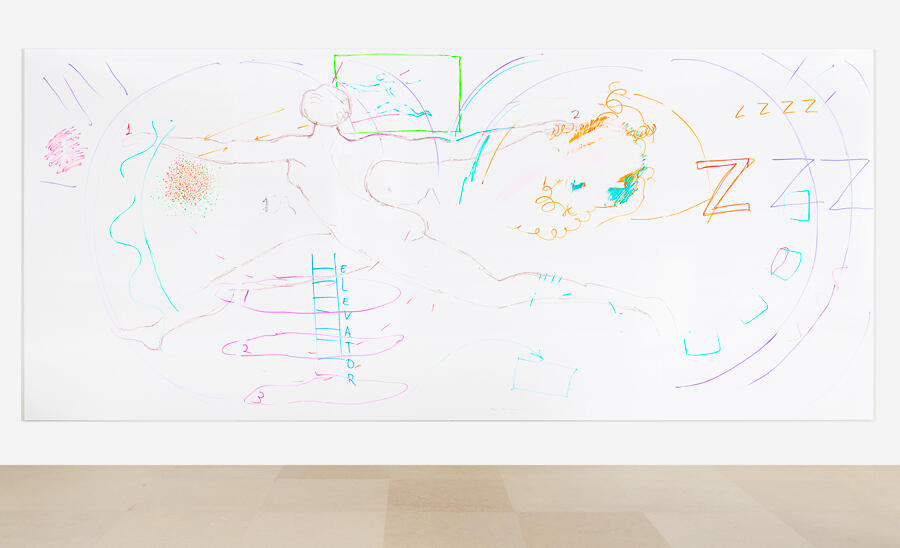Bernadette Corporation’s Too-Cool Critique Leaves You Cold
At Greene Naftali, New York, the shape-shifting collective's new paintings and sculptures reveal the limits of a generational cynicism in 2023
At Greene Naftali, New York, the shape-shifting collective's new paintings and sculptures reveal the limits of a generational cynicism in 2023

The true medium of Bernadette Corporation, the shape-shifting collective founded in 1994, has always been cultural capital. From an underground mid-1990s fashion label and a magazine (Made in USA, 1999–2001) to art films with Chloë Sevigny (Get Rid of Yourself, 2003), collaborative novels, a still-running gallery and, more recently, art exhibitions, their output – as well as the composition of their group – has morphed to explore the ways that capital manifests in various sites of commerce. Bernadette Corporation’s solo exhibition at Greene Naftali, their first in New York since 2012, sets its sights on the commercial gallery. It greets us with ten pedestals and three wall-mounted panels embellished with marker pen and an iridescent basketball. The elemental simplicity of these conceptual ‘paintings’ and ‘sculptures’ satirizes artistic virtuosity: the marker scrawls on the panels and pedestals are entirely erasable.

Opening the exhibition, Furious Flamez of Desire, Erasable (all works 2023) is a sketch of something like an old master painting, but with false starts and stops: an outstretched classical figure running, with its smaller duplicate in the distance. To the right, oversized ‘Z’s float above barely rendered concentric circles; below, the word ‘ELEVATOR’ appears vertically, maybe a nod to the gallery’s location on the eighth floor. Topped by little piles of pennies and nickels, the white laminate-clad battalion of plinths is sparsely covered in doodles and math problems. Taken together, they are meant to infantilize scientific concepts as well as reference economic instability.

The press release, written in cryptic verse, circles around the idea that the cosmos was produced from ‘something once smaller than a coin’, and then waxes on the expansion of particles, the failures of science to recognize the unity of these particles and also the economy: ‘There are coins in the show. A cosmos of them […] That recently have taken a sharp tumble in value. Arrayed thus, what futures can be seen in them?’ In Prayer/Spell, the smallest of the show’s wall-mounted works, you can discern The Lord’s Prayer written in green marker but partly obscured by a flurry of geometries of indiscernible origin; elsewhere, Diagram (World’s End, Erasable) is the group’s rendition of a fallen renaissance angel, surrounded by rays of sunlight, broken bells and a forlorn tree. Maybe there’s a connection between the fervour of the market, a commercial gallery and classical imagery, but it’s hard to take the show as an earnest exploration of spirituality or religion amidst the much stronger vibes of irony, detachment and almost disdain for commercialized art that pervade the show.

Indeed, I left wondering what role this brand of too-cool criticism has in 2023, when subcultures such as Red Scare girls and edgelords wear cynicism as a fashionable shawl. While the group originally donned its corporate guise to pre-empt its co-optation, the gesture also represented an escape from responsibility. It allowed its members, as they told Jeppe Ugelvig in Fashion Work: 25 Years of Art in Fashion (2020), to do ‘whatever they wanted and not be liable’, with performances they labelled fascion (‘the simultaneous practice of fashion and fascism’). At the time, this was a powerfully subversive form of postmodern critique, but now it uncomfortably resembles right-wing trolling. Or maybe, today, the idea of an artist as corporation is so banal as to be invisible, and a reconsideration of Bernadette Corporation’s practice is a reminder that resistance could have looked like more than reposting on Instagram. The last piece in the show is an iridescent basketball: apparently an unrealized prototype of a collaboration with the no-longer-all-that-cool streetwear brand Supreme. Sitting alone on the floor, inert, the limited-edition basketball – with all its failed promises of hype and irony – feels like a relic from a time when being too cool was resistance enough.
‘Bernadette Corporation’ is on view at Greene Naftali, New York, until 11 March.
Main image: Bernadette Corporation, Diagram (World’s End, Erasable), 2023, MDF, markerboard laminate, dry erase marker 213 × 366 × 2 cm. Courtesy: the artist and Greene Naftali, New York; photograph: Zeshan Ahmed























